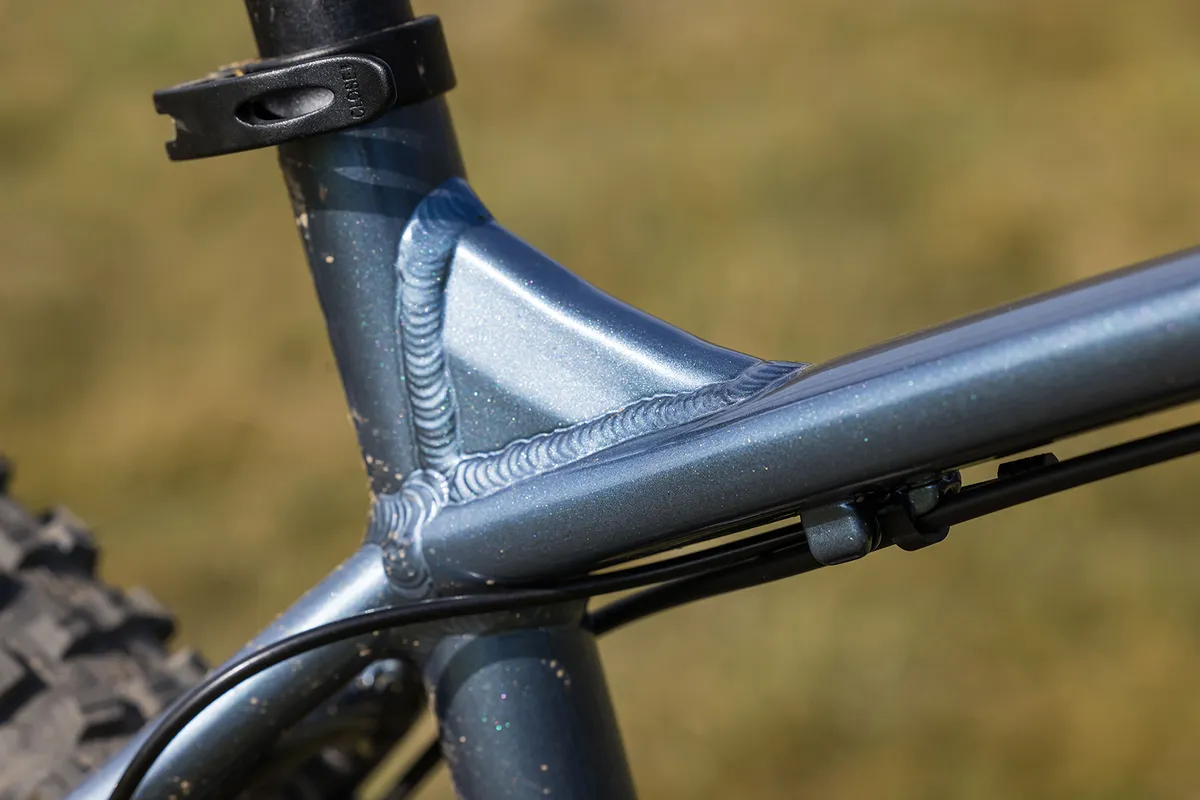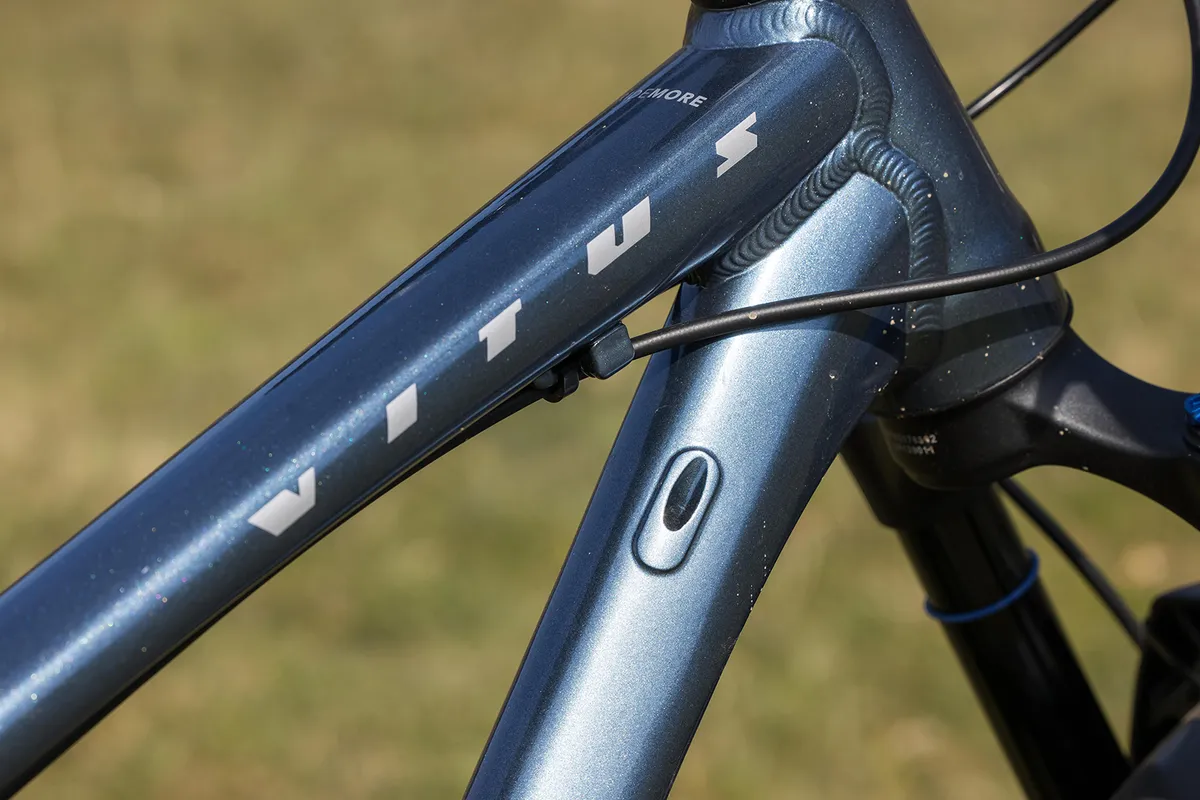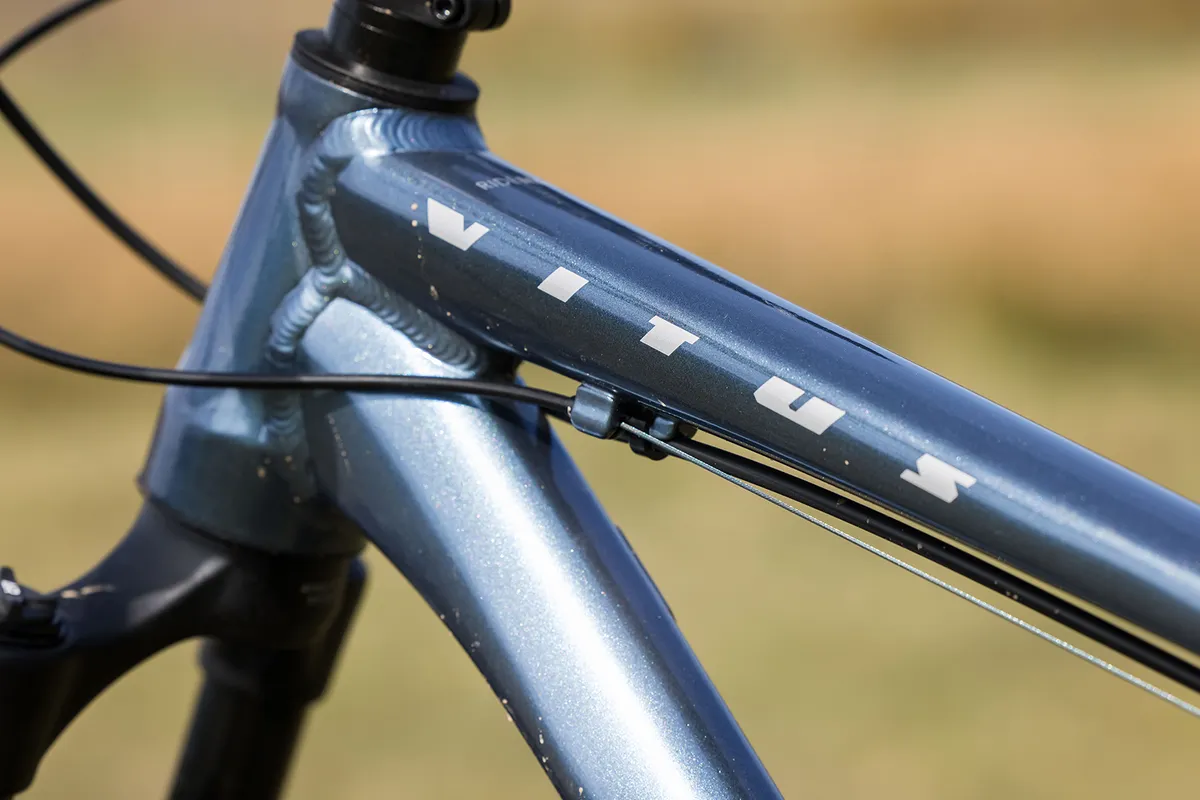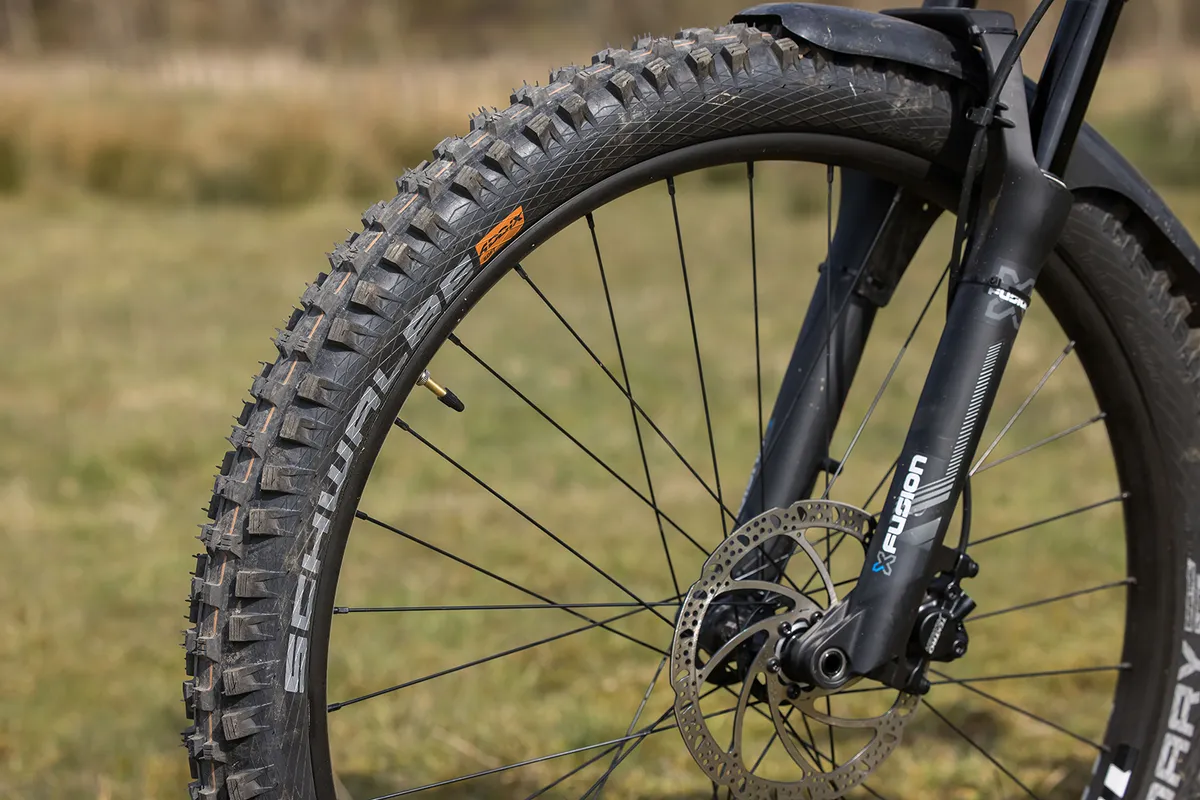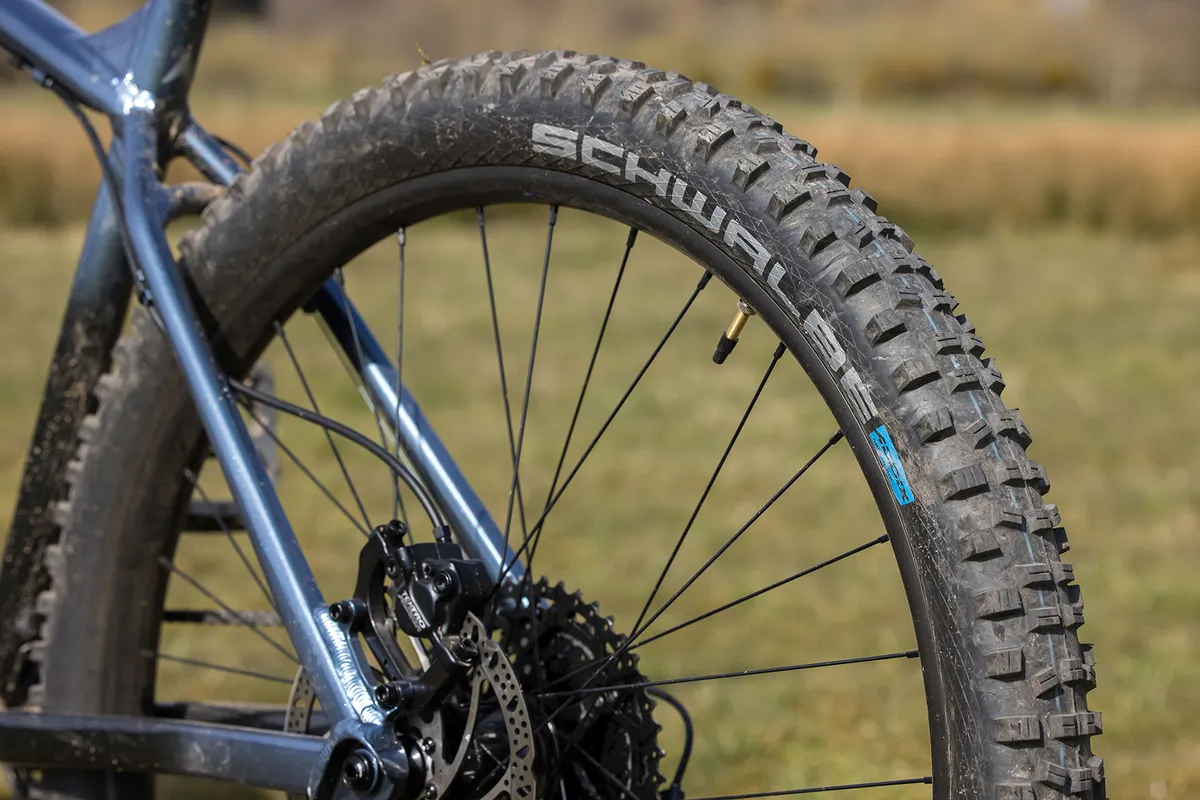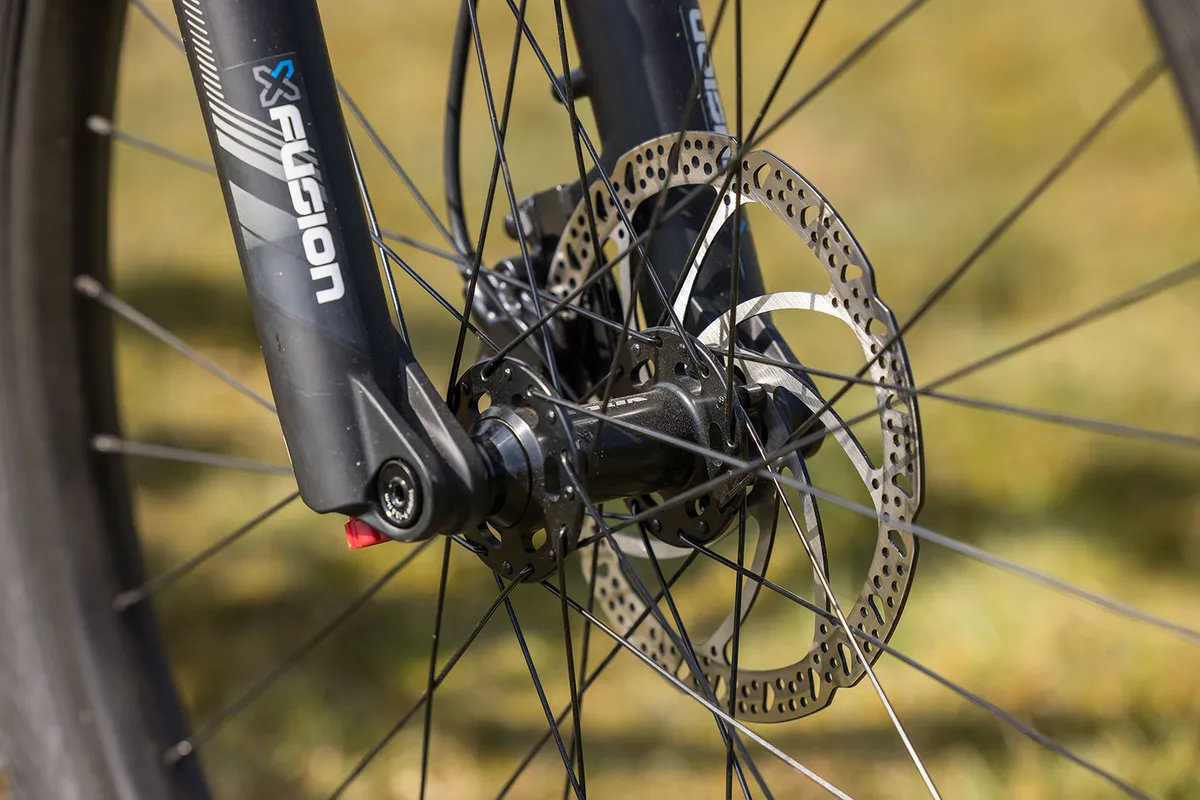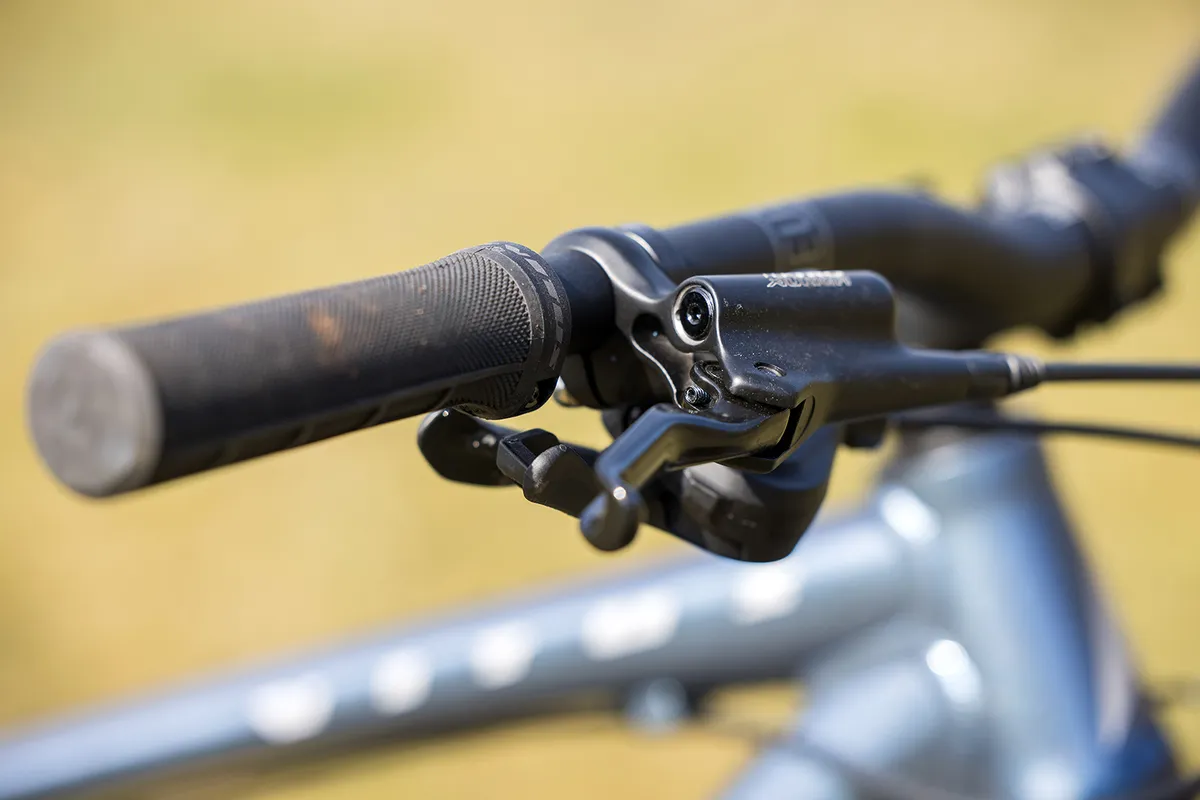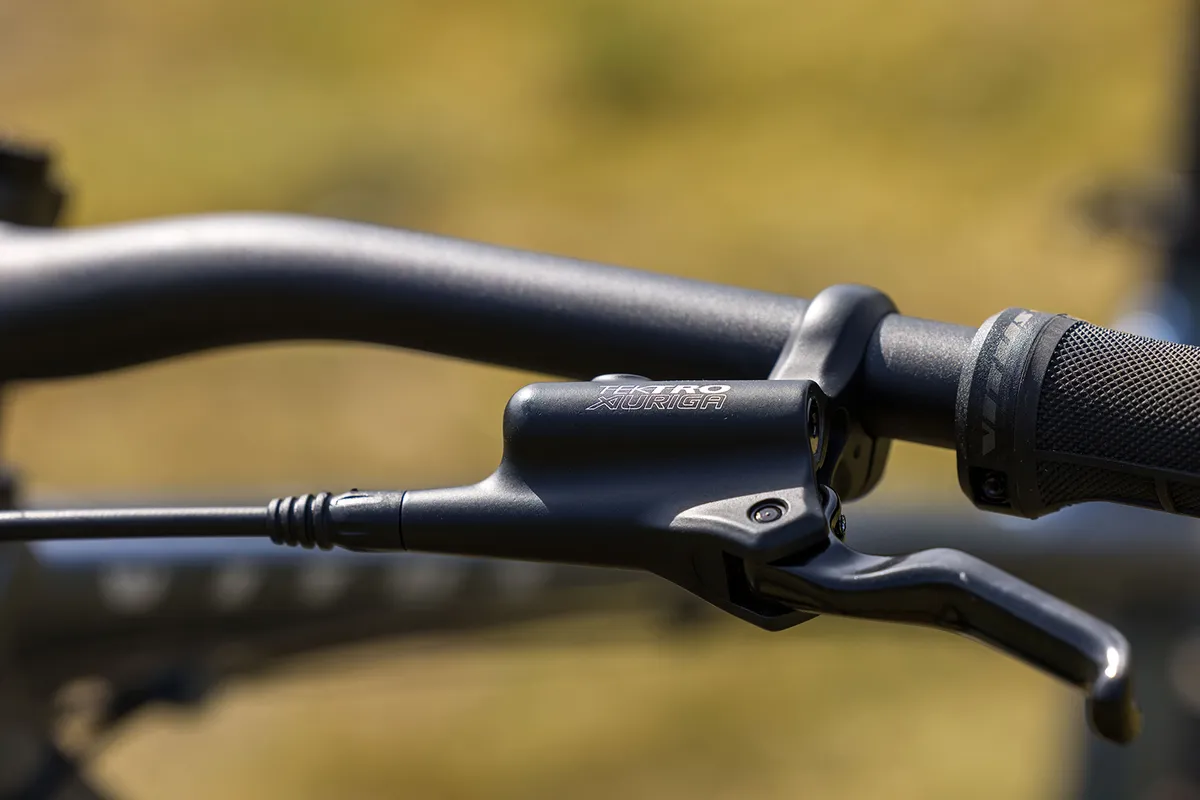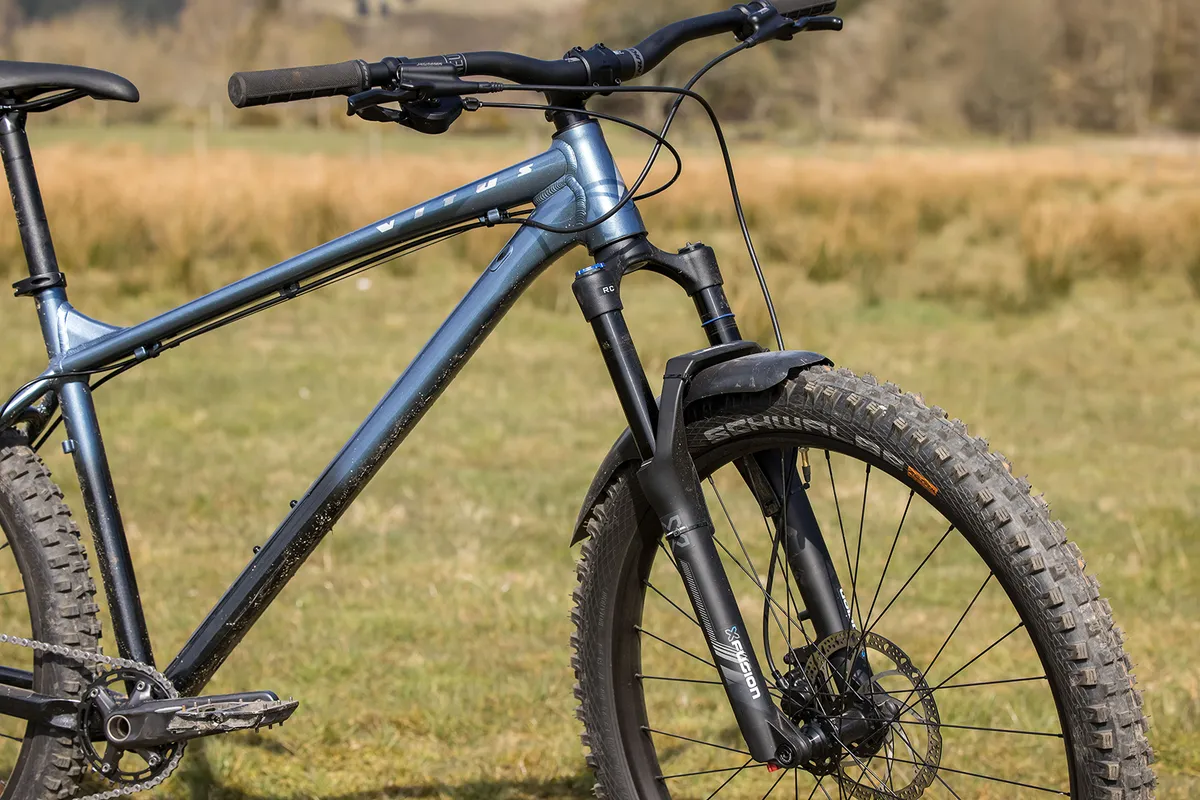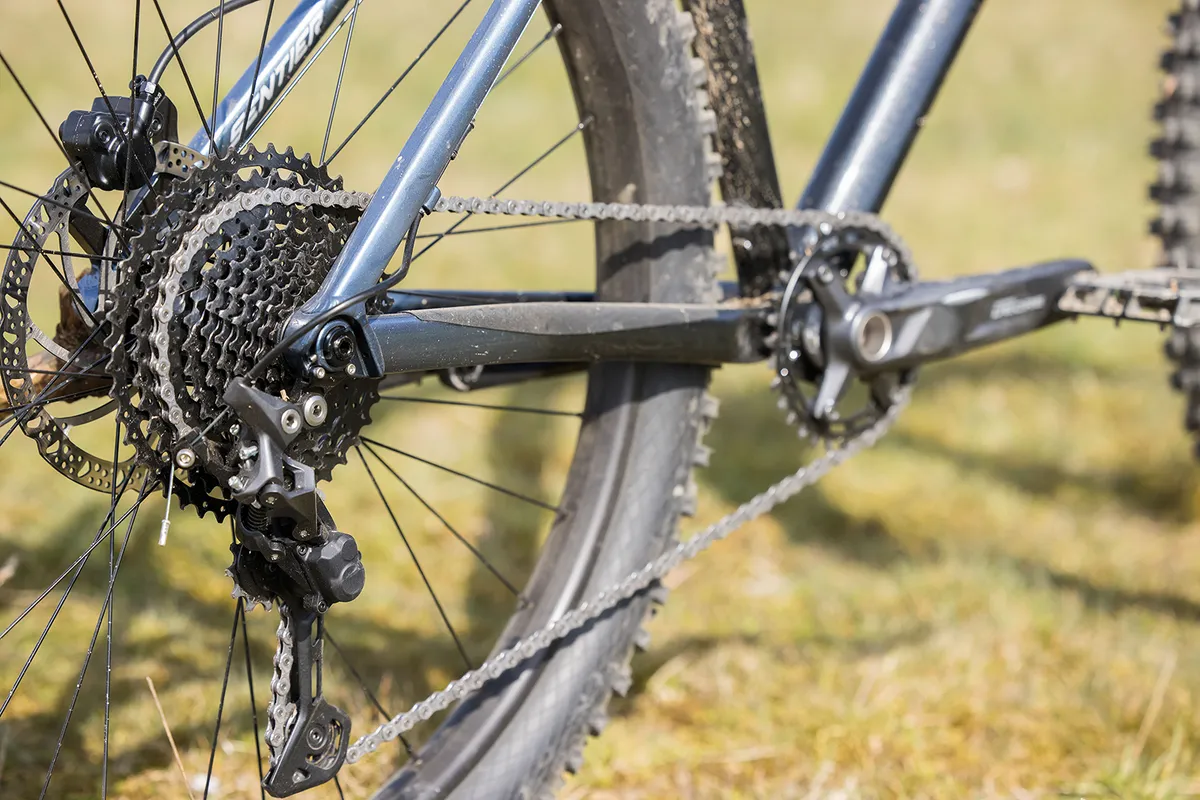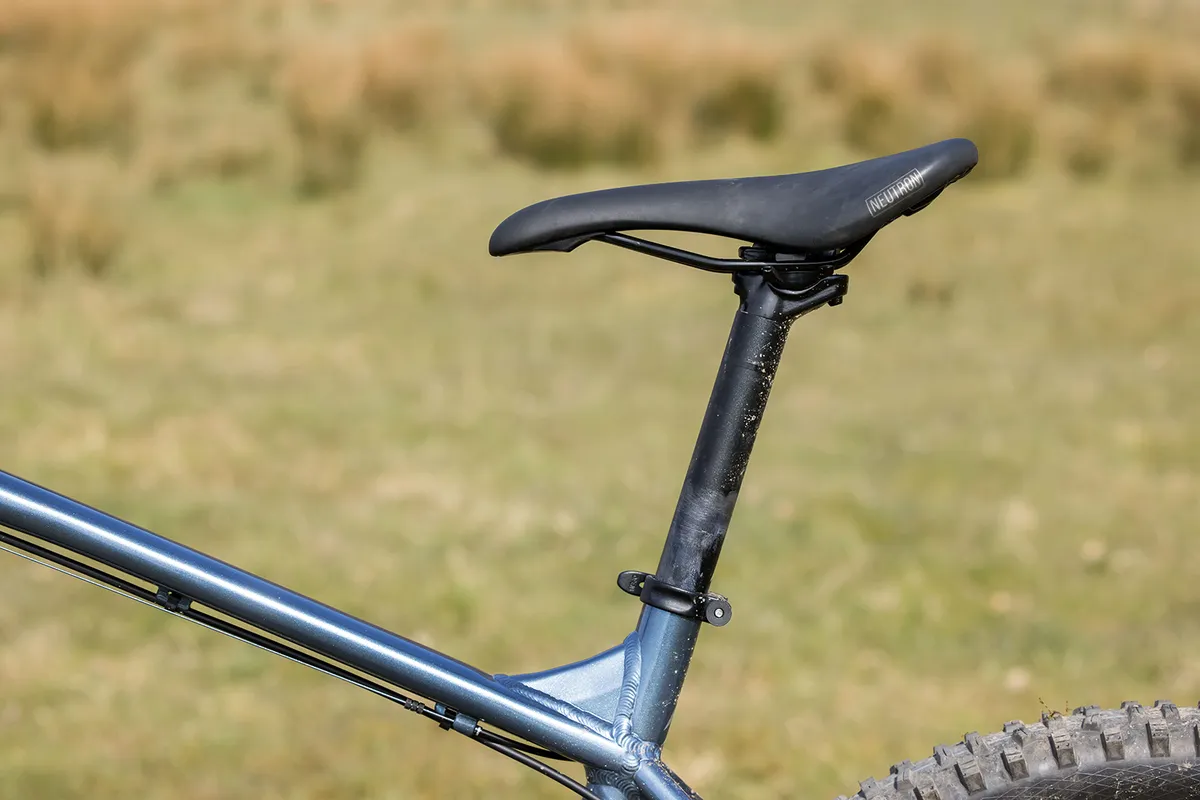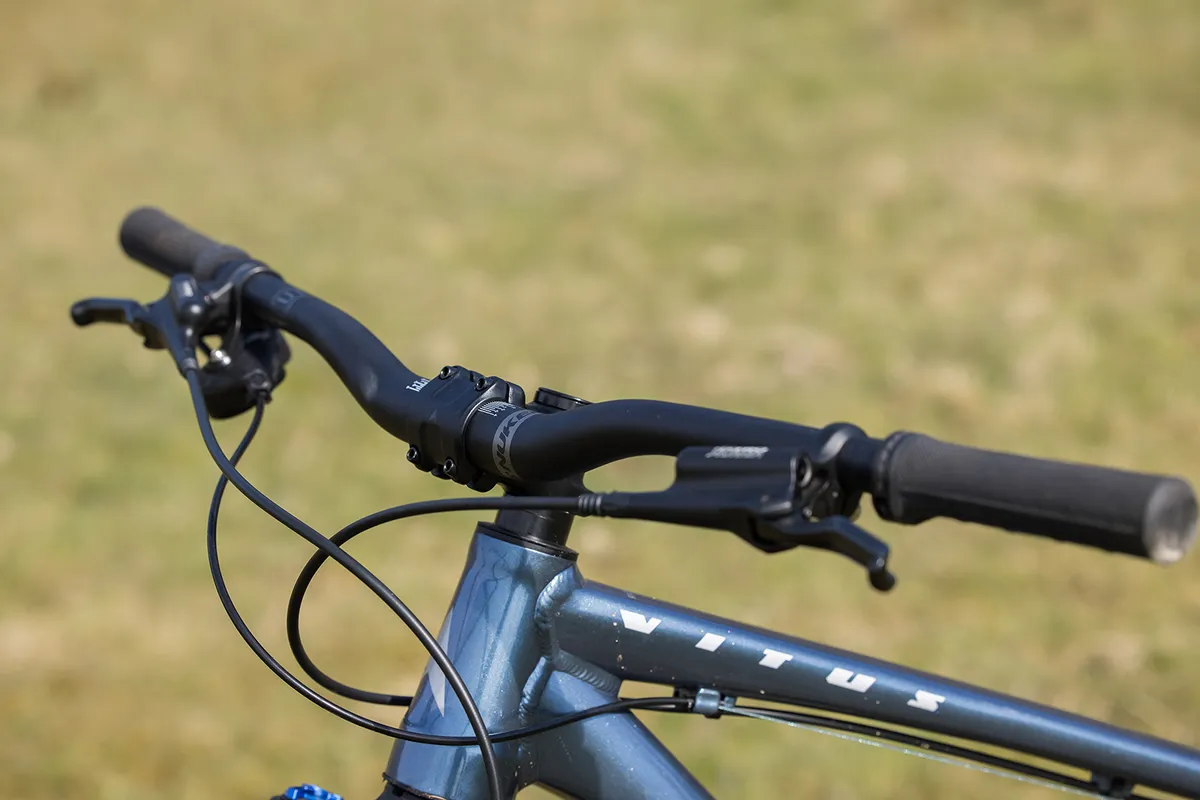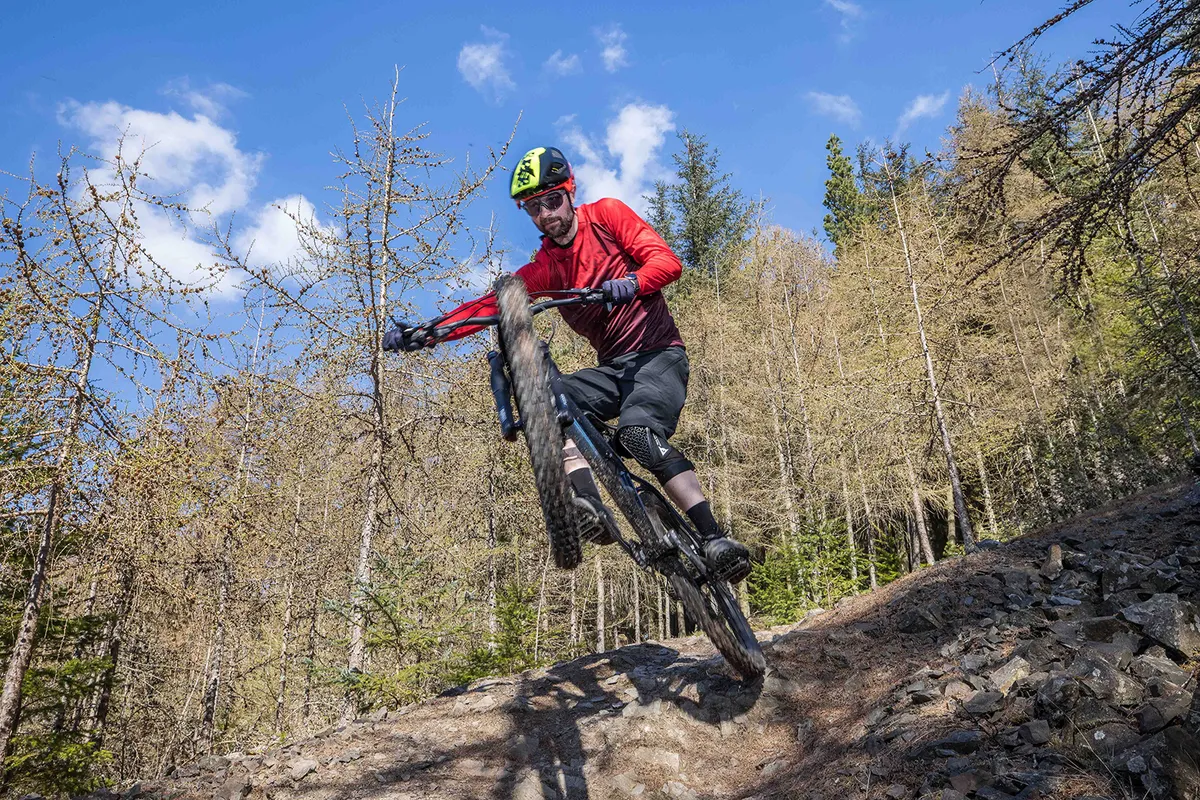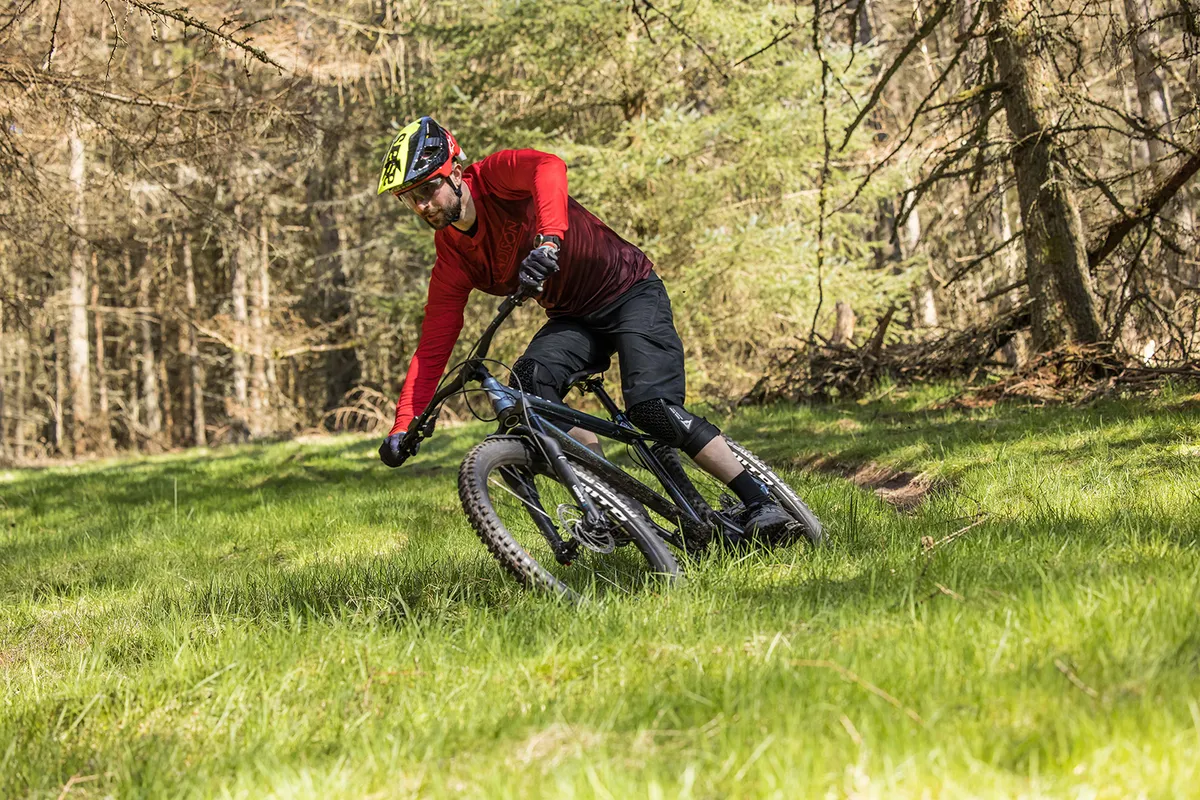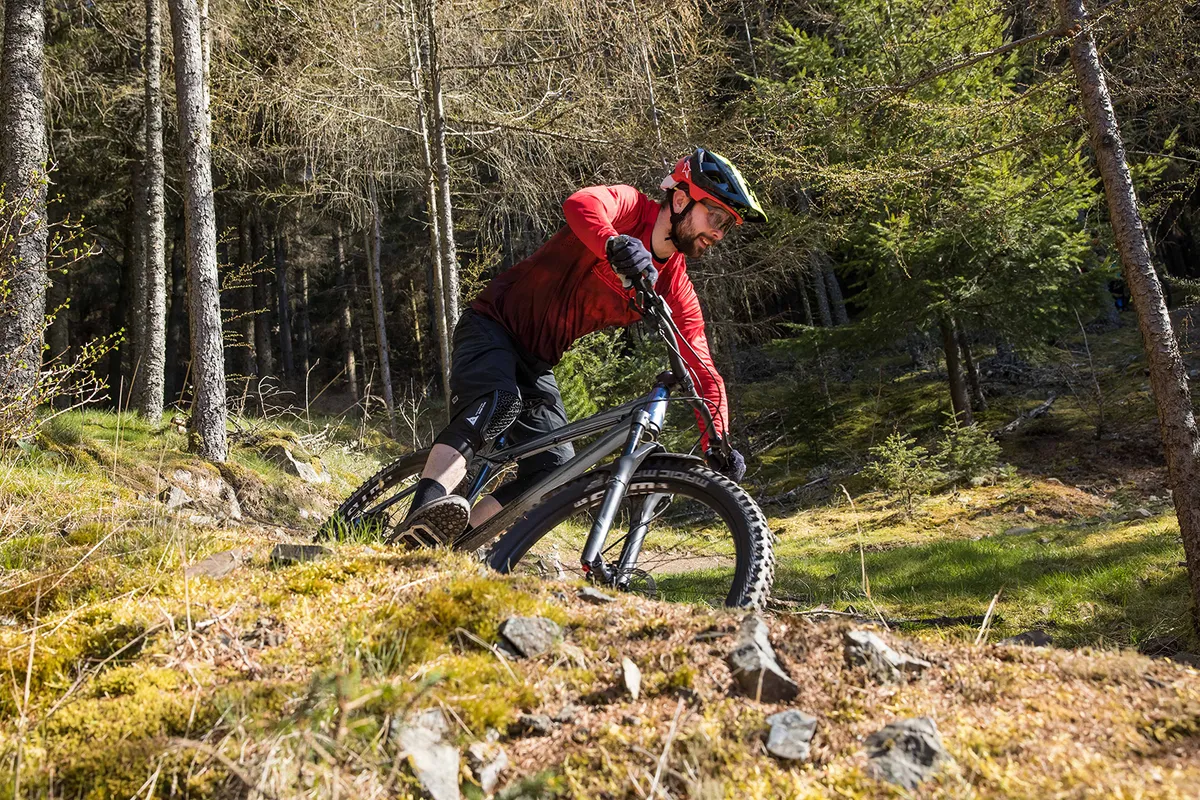Sold online, via Chain Reaction Cycles, the Sentier 27’s sleek paint job and overall spec would be at home on a bike that costs significantly more. Vitus has done such a good job of blending performance and affordability that for the budding trail rider there’s little to moan about.
This model sits at the bottom of the range but shares its frame with its pricier stablemates, which means it’s ready for choice part changes down the line.
Although there’s no dropper post, Vitus hasn’t skimped on the rest of the parts – it has a 130mm-travel X-Fusion XC32 air fork, Shimano Deore 1x10 drivetrain, WTB rims wrapped in Schwalbe Magic Mary and Nobby Nic tyres, and Tektro M290 brakes, along with finishing kit from Nukeproof and Vitus.
This version has 650b wheels, but a 29er Sentier is also available.
Vitus Sentier 27 frame and geometry
Built from double-butted 6061-T6 aluminium, the Sentier 27 looks well-finished. There’s a single bottle cage mount on the down tube, plus a cable port for an internally-routed dropper post, should you wish to upgrade.
The gear and brake cables run externally; this looks less neat than internal routing but simplifies maintenance, although the inner gear cable is left exposed to the elements under the top tube (if you want to run a continuous outer you’ll need to zip-tie it to the frame).
You get Boost rear spacing with a bolt-thru-axle, a threaded bottom bracket and a tapered head tube for improved steering accuracy. There’s not much in the way of chain slap protection.
The 650b-wheeled Sentier I tested is available in sizes small to extra-large, while the 29er version is offered in medium through to extra-large.
My large test bike had a 449mm reach – short by today’s standards – and a fairly long 483mm seat tube, along with a 1,176mm wheelbase and 425mm chainstays.
While the 66-degree head tube puts the fork at a reasonable angle, the 73-degree seat tube angle combines with the other figures to give the Vitus more of a cross-country bias, rather than leaning towards being an aggro hardcore hardtail mountain bike.
| | S | M | L | XL |
|---|---|---|---|---|
| Seat angle (degrees) | 73 | 73 | 73 | 73 |
| Head angle (degrees) | 66 | 66 | 66 | 66 |
| Chainstay (cm) | 42.5 | 42.5 | 42.5 | 42.5 |
| Seat tube (cm) | 38 | 43.2 | 48.3 | 52 |
| Top tube (cm) | 60 | 62 | 64 | 66.5 |
| Head tube (cm) | 10.5 | 11 | 12 | 13 |
| Bottom bracket drop (cm) | 4.5 | 4.5 | 4.5 | 4.5 |
| Wheelbase (mm) | 1,134 | 1,155 | 1,176 | 1,202 |
| Stack (cm) | 61.3 | 61.7 | 62.6 | 63.5 |
| Reach (cm) | 41.3 | 43.2 | 44.9 | 47.1 |
Vitus Sentier 27 kit
Thoughtfully specced, the Sentier 27’s parts are durable and perform well.
While you only get 10 gears, not the 11 found elsewhere (for that you’d need to spend £1,199.99 on the Sentier 27 VR), the 10-46t SunRace cassette and 32t chainring let you winch up most climbs, even if progress isn’t as easy as with the 51t sprocket found on the other bikes I also had on test.
The lack of a dropper may be a dealbreaker for some, but the quick-release seat clamp and lower asking price make it easier to overlook. Add one of CRC’s Brand-X posts (£139.99) and the Vitus is still great value for money.
Tyres can make or break a bike, so it’s a relief to see a 2.6in-wide Magic Mary and Nobby Nic combo, in Schwalbe’s grippy ADDIX Soft compound.
They’re wrapped around WTB’s ST i30 rims, and the whole set-up is tubeless-ready, requiring only a valve and sealant to inflate.
The 130mm-travel X-Fusion RC32 fork has external rebound and compression damping adjustment, although the latter really only works as a quasi-lockout.
As on all the bikes I had on test, the fork is air-sprung, so easier to set up for rider weight and preferences than a coil equivalent.
Tektro disc brakes with 180mm rotors slow things down. The finishing kit includes a Nukeproof Neutron saddle and 780mm bar, plus a Vitus 50mm stem and lock-on grips.
Vitus Sentier 27 ride impressions
Heading up steep climbs while in the saddle, the Sentier 27’s front wheel stays glued to the ground and doesn’t flop from side to side unless you’re taking on the toughest gradients.
Seated climbing is pretty comfortable, although the long top tube encourages a more stretched-out, XC-style riding position. This is reinforced by the long seat tube, which makes the rear end feel tall and the front end lower.
The fairly short reach makes standing climbing a little less stable. It forces your bodyweight towards the front of the bike, making it tricky to put power down without the rear wheel slipping, especially on wet ground.
The massively grippy Hans Dampf back tyre helps here, but a bit more reach – as found on the same-sized Specialized Fuse 27.5 and the larger Merida Big.Trail 500 – would mitigate the problem.
Although the saddle is one of the most personal elements of a bike, I found the convex shape of Nukeproof’s Neutron seat heinously uncomfortable when ridden for any period of time, so I swapped it for the flatter Specialized Bridge from the Specialized Fuse.
Once my backside was a little happier, the 2.6in width of the Schwalbe tyres not only added to impressive soft-ground grip, but also allowed me to run lower pressures, increasing comfort on rougher trails.
The 32x46t lowest gear left me at the very limit of comfort on steep climbs. A 30t chainring would make things easier, as supplied on the 29er Sentier, and other similar bikes benefit from Shimano’s 51t largest cassette sprocket.
On rougher trails, the Sentier 27’s external routing keeps things quiet, with none of the internal cable rattle that I experienced on Specialized's Fuse 27.5.
The 10-speed Deore rear mech’s clutch mechanism helps minimise chain slap, and the chain didn’t derail from the chainring during the test period.
The X-Fusion fork has fairly basic damping, resulting in a tendency to dive through its mid-stroke in berms or compressions. Increasing the spring pressure helps to an extent, but reduces comfort slightly, especially when climbing.
Even with higher pressures, small-bump sensitivity is still good and I didn’t feel like grip had been compromised, especially when riding faster. The overall sensation of grip and comfort is aided by the chunky tyres – a great spec choice from Vitus.
That short reach makes the Sentier 27 feel quite twitchy at higher speeds or down steep trails and caused me to feel like I was quite far forwards when standing.
On top of that, the long seat tube made it impossible to get the saddle fully out of the way, leaving it to kick me in the backside down steep stepped sections. Once I’d increased the fork pressure to help prop up the front end, these issues were reduced.
For shorter-legged riders, the seat tube limits the bike’s downhill capability, so it’s worth carefully measuring the maximum length you’d be comfortable riding, to avoid disappointment.
General descending prowess and control is good, though. At lower speeds or on flatter trails, the Sentier 27 is a hoot to ride because it’s easy to flick around. This is a bike that’ll suit someone whose riding style is more playful, rather than focused on outright speed – although even for them, a longer reach wouldn’t be detrimental to its handling.
The Tektro brakes have shorter lever blades than some other stoppers, which encourages one-finger braking. However, they have a wooden feel and lack power.
The brake pads also rattle in the calipers, interrupting an otherwise noise-free ride. Up front, the wide Nukeproof bar feels good and the Vitus grips are comfy without being too thick.
Vitus Sentier 27 bottom line
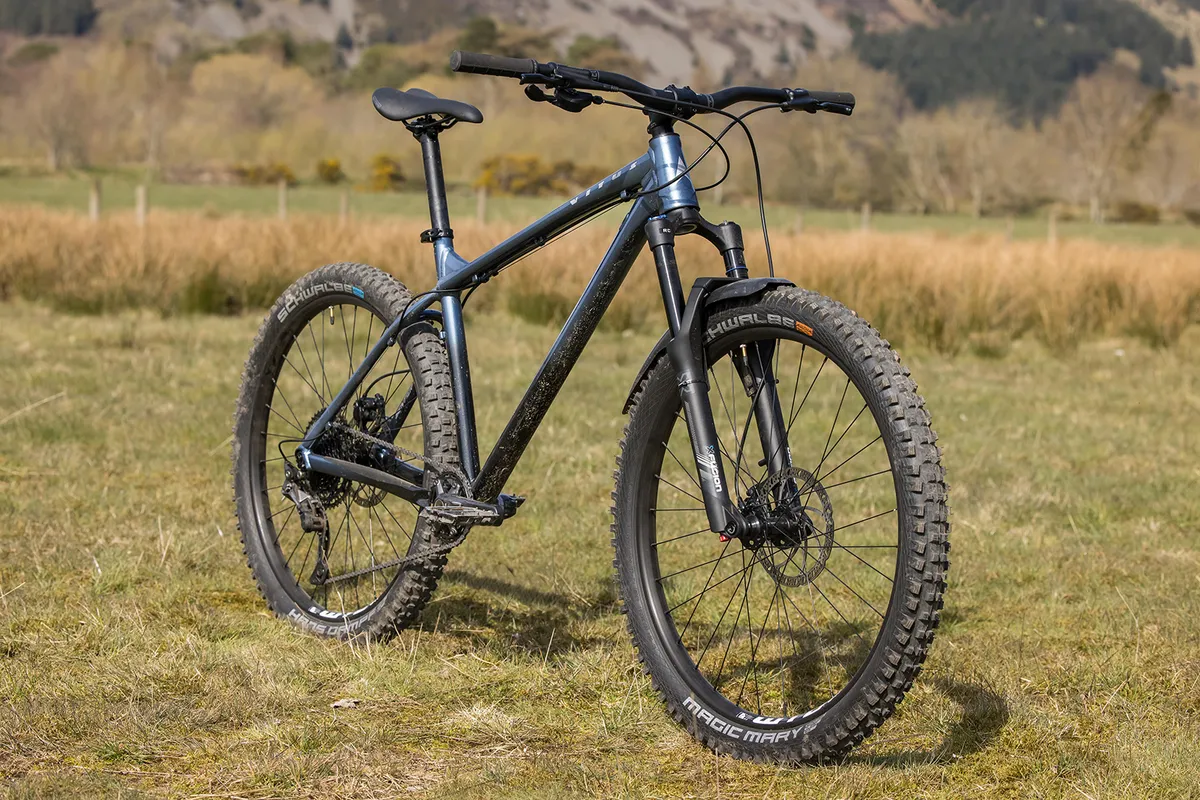
Despite its shortcomings, it’s hard to argue with the value and performance on offer from the Sentier 27. On paper, it looks better than its 29in-wheeled doppelganger, which is specced with the same parts but costs £50 more and has slightly more conservative geometry.
The only real omission from the spec is a dropper post, which is only a £140 upgrade away. In the meantime, the quick-release seat clamp makes it easy to change your saddle height manually.
If you’re considering the Vitus, make sure to take a good look at the geometry first – especially the seat tube length – and work out whether it’ll suit you, to avoid disappointment on the downs.
How we tested
We put three bikes to the test to see if you can get a totally sorted, trail-slaying hooligan of a bike for around the £1k mark or if you need to spend a little more.
At around £1,000 you’re best off looking at hardtails (bikes with no rear suspension) because the parts they’re specced with are going to be much better than on an equivalently-priced full-sus bike. You can expect a wide-range 1x drivetrain, with some brands offering 12-speed set-ups.
You’re likely to find a mix of air- and coil-sprung forks at this price, the majority with basic adjustments, such as a lockout lever and rebound dial.
One of the key things to look for is upgradability. As your skills improve, you’re going to hanker for better kit, but your options will be limited if the frame isn’t up-to-date.
Keep an eye out for Boost (148×12mm) rear axle spacing and cable routing for a dropper post (if the bike doesn’t come with one), both of which will unlock changes to shed weight or improve flow.
All frames at this price will be made from aluminium alloy, but build and material quality varies. Bikes come with either 29in or 650b (aka 27.5in) wheels, with the smaller size generally found on models aimed at more aggressive riding/riders.
Also on test
Product
| Brand | vitus |
| Price | 2550.00 AUD,1300.00 EUR,900.00 GBP,1100.00 USD |
| Weight | 13.3600, KILOGRAM (L) - |
Features
| Fork | X-Fusion RC32, 130mm (5.11in) travel |
| br_stem | Vitus, 50mm |
| br_chain | KMC X10 |
| br_frame | Double-butted 6061-T6 aluminium alloy |
| Tyres | Schwalbe Magic Mary SnakeSkin TL Easy ADDIX Soft 27.5x2.6in (f), Schwalbe Nobby Nic SnakeSkin TL Easy ADDIX Speedgrip 27.5x2.6in (r) |
| br_brakes | Tektro M290, 180mm rotors |
| br_cranks | Shimano Deore M5100, 32t |
| br_saddle | Nukeproof Neutron |
| br_wheels | WTB ST i30 rims on Vitus KT hubs |
| br_headset | Acros |
| br_shifter | Shimano Deore M4100 |
| br_cassette | SunRace CSMS2, 10-46t |
| br_seatpost | Vitus rigid |
| br_gripsTape | Vitus |
| br_handlebar | Nukeproof Neutron V2, 780mm |
| br_bottomBracket | Shimano BB52 |
| br_availableSizes | S, M, L, XL |
| br_rearDerailleur | Shimano Deore M5100 (1x10) |
